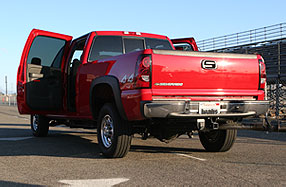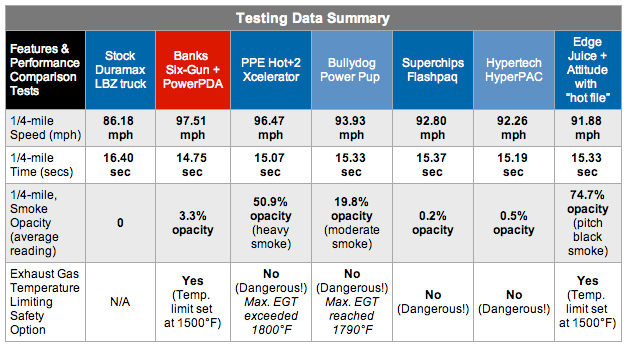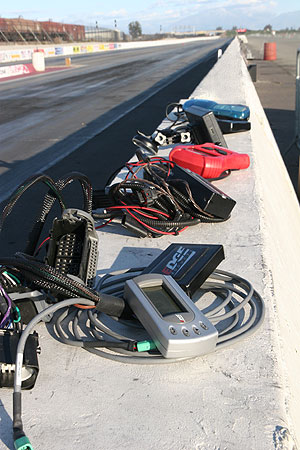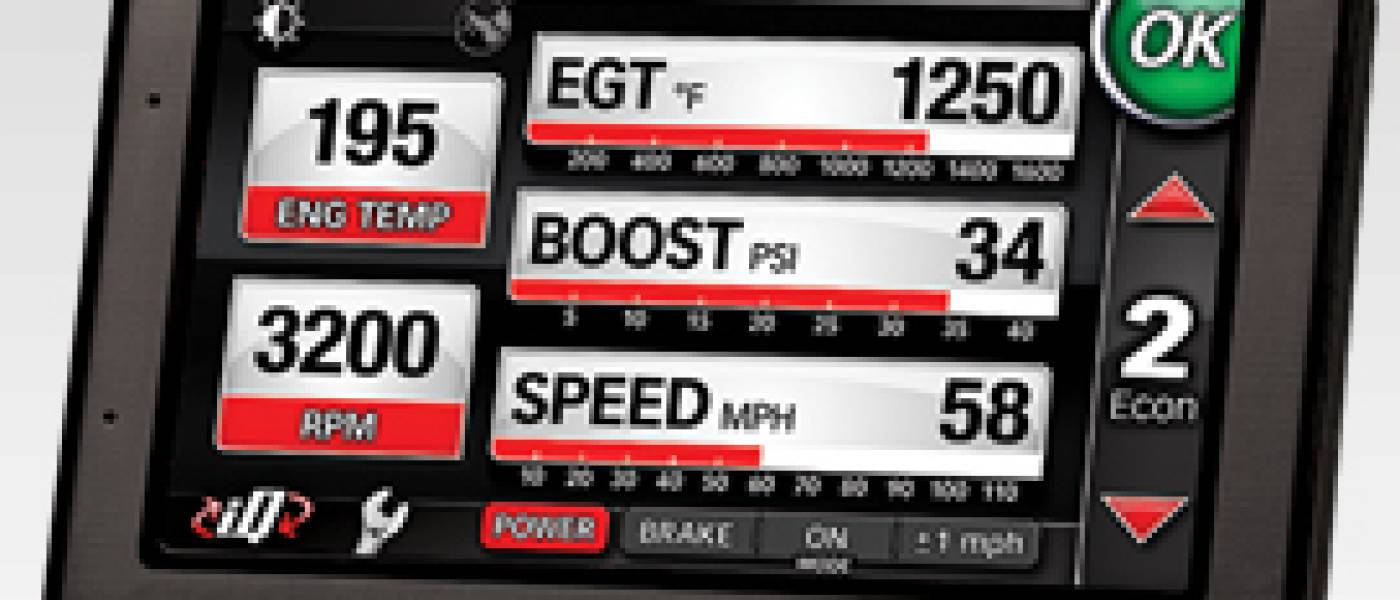Six-Gun Shootout
Banks Test Group compares the Six-Gun Diesel Tuner to other company’s tuners on the drag strip. Same truck. Same track. Same day. Same driver. Only the electronics were changed.

By Peter Treydte
How does Banks Six-Gun Diesel Tuner stack up against other tuner/programmers on the market?
All tuner companies make claims about horsepower and torque gains from their products. At Banks, we do more than just talk. We test. We put real-world trucks in real-world conditions to show just what you can expect from a Banks product.
With our Six-Gun Diesel Tuner, we took that testing a step further. Not only did we submit the Six-Gun to instrumented quarter-mile acceleration runs in measure of speed, smoothness and smoke-free operation, we compared it to several other tuners on the market. To keep this an apples-to-apples comparison, we installed all the tuning components on the same truck, used the same track (the Auto Club Raceway at the Pomona Fairplex, home of the NHRA Winternationals), performed all the tests on the same day, and used the same driver for each run. Because our goal was an accurate product comparison, we did all we could to minimize variables between runs. We did not make any other changes to the test truck to lower its elapsed times. The performance figures you see here are based solely on the effects the different electronic tuners had on the test truck.
Note: The PowerPDA used in this test has now been upgraded to the Banks iQ.

 | Test Vehicle
Our test mule was a 2006 Chevrolet Silverado Crew Cab Short Bed 4×4 with a 6.6L Duramax LBZ diesel engine, Allison 6-speed automatic transmission and single rear wheels. All tests were run in 2WD. Two people were in the truck during testing, the driver and the operator of the test equipment. Test results – timing, multiple temperature and pressure channels – were gathered via a data acquisition system. The only modification made to the truck (other than the addition of the various electronic tuners) was the replacement of the stock rear tires with a set of drag slicks to reduce the variable of tire slip at launch. The slicks were approximately 2 inches taller than the stock tires, and therefore affected the Vehicle Speed Sensor (VSS). In order to record accurate speeds during the test runs, we relied on the data acquisition system’s GPS rather than the VSS. On the NHRA scales, the truck, with a full tank of fuel, test equipment and two people on board, weighed 7,360 pounds. |
 | Test Conditions
Ambient temperatures ranged from 58 to 63 from the beginning of the test sequence to the end. Barometric pressure was 29.65 and relative humidity was 24%. A headwind of about 10 MPH was observed during the entire test sequence. |
 | Test Method
The right lane of the drag strip was used for all runs. A minimum of three runs for each product was performed to ensure repeatability. The vehicle was launched from a standing start without torque braking the vehicle, in the interest of minimizing variables. A quick burnout was performed before each run to ensure a clean surface on the tires. Data was analyzed and the 1/4 elapsed times were evaluated in the method that NHRA would use which includes a 1 foot rollout at the start. Elapsed time is then observed at the 1319 foot mark and the average speed over the last 60 feet is taken. The best run of three is taken for comparison. The gear selector was in “D” (no manual influence on the transmission). Shift points generally occur around 3200 RPM and the vehicle is in 5th gear when it completes the 1/4 mile. |
 | Data Acquisition
Along with multiple engine related temperature and pressure data, GPS information was gathered and used to evaluate accurate 1/4 mile information. An opacity meter was mounted to the tailpipe to evaluate the exhaust soot. |

| Stock
To gather baseline data on the truck’s performance, we made our initial runs with the truck in its stock configuration. The best quarter-mile e.t. was 16.40 seconds at a trap speed of 86.18 mph. Upshift points occurred between 3,150 and 3,200 rpm, and the torque converter clutch locked while in Second gear. No smoke was observed or measured on the opacity meter. |
| Banks Six-Gun Diesel Tuner With PowerPDA
The first product tested was the Banks Six-Gun, teamed with the PowerPDA. We tested the Six-Gun at its highest setting, and left most of its default settings alone. The only modification we made was to remove the Fifth gear derate, a Six-Gun default value that reduces added fuel delivery by 40 percent. This change to the calibration was done through the portable PowerPDA, which controls, monitors and records performance functions and 15 engine parameters. Through the PowerPDA we were able to set the exhaust gas temperature (EGT) limit at 1,500 degrees F. During the testing, a small puff of smoke was visible immediately after launch and during the 3-4 gear shift – shifts that were smoothed by the Six-Gun’s protective calibration. Yet as you can see from the accompanying chart, those small smoke puffs barely budged the opacity meter. After the tests were complete, the truck’s best e.t. was 14.75 seconds at a trap speed of 97.51 mph – more than a second and a half quicker than the best stock run, and more than 10 mph faster. |
| PPE Hot+2 Xcelerator
This programmer-style product has six available levels: Economy (40 hp), Tow (90 hp), High (160 hp), Race (225 hp), Hot (300 hp) and Hot+2 (350 hp). We raised the vehicle speed limiter to 100 mph so it wouldn’t influence the test results. Because it was a programmer-style product, there was no provision for temperature limiting control. All other tuning parameters were left at their default values. Initially, we opted to test the truck at the highest level (350 hp), but the first test run was aborted due to turbine inlet temperatures exceeding 1,800 degrees F about midway through the run. We then selected the next level down (300 hp) and were able to complete our testing, despite the fact that the turbine inlet temperature still exceeded 1,800 at the end of the quarter mile. The 300hp setting resulted in a best e.t. of 15.07 seconds, which was the second quickest of the competing tuners but still slower than the Banks Six-Gun with PowerPDA by more than three-tenths of a second. We also experienced some drivability issues with the PPE programmer: Because it was calibrated to pull fuel back during each gearshift, the shifting performance was harsh and abrupt. We also observed heavy smoke throughout the runs, with opacity exceeding 85 percent at times. |
| Bullydog Power Pup
This programmer-style product has three available levels: Tow/Econ, Perform, and Extreme. We selected the Extreme level for the test, and raised the vehicle speed limiter to 100 mph so it wouldn’t influence the test results. Because the Power Pup is a programmer-style product, there was no provision to limit or control EGT. After testing was completed, the Power Pup’s best 15.33-second e.t. was four-hundredths of a second quicker than the Flashpaq, but still nearly six-tenths of a second behind the Banks Six-Gun. Worse, the engine produced a moderate level of smoke during the entire run, and the maximum EGT reached a dangerous 1,790 degrees. |
| SuperChips Flashpaq This programmer-style product has three available levels: Tow, Perf/Tow and Performance. We selected the Performance level for the test, and set the vehicle speed limiter to “Raised” so it wouldn’t influence the test results. Because the Flashpaq is a programmer-style component, there was no provision to limit or control EGT. During the test our opacity meter measured very little smoke, but very little acceleration improvement, too. The best quarter-mile e.t. was just 15.37 seconds, which was faster than the truck in stock trim but slower than any of the other programmers – and more than six-tenths of a second slower than the truck equipped with the Six-Gun. In drag-strip terms, that’s huge. |
| Hypertech HyperPAC This programmer-style product has a display with three available levels; we selected the highest level for the test. The vehicle speed limiter was raised to 100 mph so it wouldn’t influence test results, and all shifting variables were left at their default values. The HyperPAC does have a means of monitoring EGT (an interface for a thermocouple), but there’s no corresponding way to control fuel delivery based on that information. All you get is a warning of high exhaust gas temperature. With a best e.t. of 15.19 seconds, the HyperPAC produced one of the quicker acceleration runs among the competing programmers. That number still fell short of the Six-Gun’s best by nearly half a second, and did so without any means of controlling exhaust gas temperature. |
| Edge Juice This This tuner-style product is configured to deliver power increases at selectable levels between 30 and 50 horsepower. We selected the highest, 50hp setting for our test. In this configuration there were no adjustable parameters and no means of limiting EGT. The Juice’s best e.t. of 15.35 seconds was the second slowest of all the tuner test runs – six-tenths off the Six-Gun’s best. The 91.36-mph trap speed was the slowest of the lot – more than 6 mph off the pace set by the Six-Gun-equipped Duramax. |
| Edge Juice With Attitude For our next test, we combined the “Attitude” display with the Edge Juice. This provides two more power levels, 60 and 80 horsepower; we chose the highest setting for our tests. Temperature limiting was also an available feature with the Attitude, and we set the maximum allowable EGT value to 1,500 degrees F. All other parameters were left at their default values. During our test runs, we noticed a large amount of smoke coming from the tailpipe, and the opacity meter registered readings between 75 and 90 percent when the truck was in Fourth gear. This much black smoke is an indication that excessive fuel is being delivered to the engine and passing through, unburned, during the combustion cycle. Although the 14.82-second e.t. was comparable to the Banks Six-Gun, the speed at the end of the quarter mile was 1.66 mph slower than the Six-Gun, indicating a lack of high rpm performance. We also experienced sporadic shift characteristics during the tests. |
| Edge Juice With Attitude And Hot File Edge offers an additional, 100hp power level for its Juice with Attitude tuner by selling an unlock code for a “Hot File.” The charge for this code is reportedly $100. Save your money. In this configuration, the truck was actually slower than all previously tested tuners except for the Edge Juice set to the 50hp level and the SuperChips Flashpaq. During the run, the Check Engine Light came on, indicating an ECU error for low fuel-rail pressure. This forced the truck into a low power (limp-home) mode, a condition that occurred in each quarter-mile pass. We also observed excessive smoke throughout the run, with opacity approaching 100 percent (pitch black) during the second half. As with the 80hp level, shift characteristics were sporadic. |
Test Summary
 The quarter-mile times of the competing programmer/tuners were all slower than the Banks Six-Gun, by as little as .07 seconds (Edge Juice with Attitude) and by as much as .62 seconds (SuperChips Flashpaq). Yet the elapsed times tell just part of the story. Each of the competing products presented smoke and/or drivability issues that weren’t evident when the Six-Gun was used to tune the Duramax.
The quarter-mile times of the competing programmer/tuners were all slower than the Banks Six-Gun, by as little as .07 seconds (Edge Juice with Attitude) and by as much as .62 seconds (SuperChips Flashpaq). Yet the elapsed times tell just part of the story. Each of the competing products presented smoke and/or drivability issues that weren’t evident when the Six-Gun was used to tune the Duramax.
Among the Edge products, for example, the Hot File is clearly not worth the additional money that it costs because it simply cannot be used without setting a code, putting the vehicle into limp-home condition. The two highest settings with the Edge resulted in the highest opacity readings – the blackest smoke – during the test sequence. Excessive black smoke is an indication of wasted power and fuel.
The PPE Hot+2 Xcelerator has the highest advertised power numbers. The highest level that we could test has an advertised rating of 300 additional flywheel horsepower, yet it was slower in the quarter mile than the Six-Gun on level 6, which has an advertised rating of 100 additional rear-wheel horsepower. This is a clear indication that their horsepower claims are inflated. In addition, the highest power settings of their product are unusable under most conditions due to high exhaust gas temperatures.
The Bullydog Power Pup had the second highest turbine inlet temperature after the PPE Hot+2 Xcelerator at 1,791 degrees F. High EGTs are another indication of poor tuning. Because this product is a programmer, it does not offer the protection of an EGT limiting feature, and therefore it could seriously damage the engine.
Both the Edge and PPE products caused harsh, erratic shifting. The PPE product caused damage to the transmission resulting in slippage, a situation we uncovered when we tried to re-baseline the truck after testing all the tuner/programmers. The e.t.’s did not compare to the original runs due to transmission slippage, a condition that began to occur during the PPE testing.
Conclusion
The Banks Six-Gun Diesel Tuner clearly generated the best acceleration times throughout a day of no-holds-barred, head-to-head testing, in some cases by more than a half-second through the quarter-mile. Better still, the Six-Gun achieved its results with a minimal amount of smoke output, and maintained exhaust gas temperatures well within a safe range. A tuner/programmer shouldn’t kill your engine. But as you’ve seen, some of them could be hazardous to your diesel’s health. Don’t put your truck’s powertrain at risk. Choose Banks.
Appendix: Testing Methods & Conditions
To minimize testing variables, all runs were done in the drag strip’s right lane. After a quick burnout before each run to clean the slicks, the test driver launched the truck from a standing start without torque braking. All runs were made with the transmission in Drive. The Allison typically shifted at around 3,200 rpm, and the truck reached Fifth gear by the end of the quarter mile.
We made a minimum of three runs with each product to make sure we were getting repeatable results. The quarter-mile data were evaluated per the NHRA’s method, with the elapsed time taken at the 1,319-foot mark and the average speed recorded over the last 60 feet. We used the best run from each group of runs as the basis for our comparison.
In addition to using a GPS system to measure our quarter-mile acceleration runs, on-board data acquisition equipment logged multiple engine-related temperature and pressure data. We also mounted an opacity meter to the tailpipe to evaluate exhaust soot.
Because of the mild spring conditions on our test day, ambient temperatures varied only from 58 to 63 degrees F from the beginning of the test sequence to the end. Barometric pressure was 29.65, and relative humidity was 24 percent. We noted a headwind of about 10 mph during the entire test sequence.
WHITE PAPER: Six-Gun Diesel Tuners
See the Six-Gun Diesel Tuner for your:
’07-09 Duramax LMM
’06-07 Duramax LLY-LBZ
’04-05 Duramax LLY
’01-04 Duramax LB7
’03-07 Cummins
’08-09 Power Stroke 6.4L
’03-07 Power Stroke 6.0L



